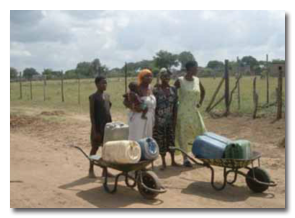Rechercher

Accueil du site > Equipes de Recherche > Mortalité liée au sida et caractéristiques des ménages en Afrique du Sud rurale : implications pour l’utilisation des ressources naturelles et le développement > Problem, objectives, contexts and challenges
Household characteristics in rural South Africa : implications for natural resources and development
Problem, objectives, contexts and challenges
This project sought to explore relationships between household characteristics and experience of a prime-age adult mortality, and household use patterns of key natural resources in a rural sub-district of South Africa. The implications of such associations for development in rural African settings were assessed in a context of rising adult mortality due to HIV/AIDS, increasing levels of environmental degradation, and the centrality of natural resources in rural livelihoods. The study was conducted in the far north east of South Africa, in the Agincourt sub-district of Bushbuckridge district, Limpopo Province.
There is a significant lack of research as to how population and economic factors interact to influence household use of natural resources in rural South Africa. This information is a key to understanding the complex interactions between humans and the environment, and the development implications of these interactions, within these less developed communities, particularly in the face of high HIV/AIDS prevalence, environmental degradation and high reliance on natural resources.
 This project specifically addresses these issues, within the context of the affect of AIDS mortality, by investigating patterns of use of key natural resources by rural households, as influenced by a recent mortality of a household member in the productive age group most vulnerable to AIDS mortality, as well by household size, composition and wealth status. The project took a novel approach to understanding the population-environment-development (PED) relationship by focusing on the development implications of resource use, with household-level natural resource use acting as a mediating factor between population factors and development potential. We also carefully integrated consideration of the impacts of HIV/AIDS upon household dynamics, resource use, and relevant development implications.
This project specifically addresses these issues, within the context of the affect of AIDS mortality, by investigating patterns of use of key natural resources by rural households, as influenced by a recent mortality of a household member in the productive age group most vulnerable to AIDS mortality, as well by household size, composition and wealth status. The project took a novel approach to understanding the population-environment-development (PED) relationship by focusing on the development implications of resource use, with household-level natural resource use acting as a mediating factor between population factors and development potential. We also carefully integrated consideration of the impacts of HIV/AIDS upon household dynamics, resource use, and relevant development implications.
This project aims to address the following key questions within the context of a rural area in South Africa : 1) What are the associations between natural resource selection, use, consumption and acquisition strategies and the household characteristics of size, composition and economic status in rural South Africa ? ; 2) Beyond these household characteristics, how is prime-age adult mortality associated with the ways in which households select, use, consume, and acquire key natural resources ? ; 3) What are the implications of these associations for development in the context of rising AIDS mortality among poor rural communities ?
Dans la même rubrique :